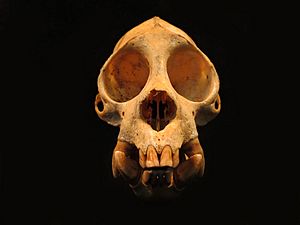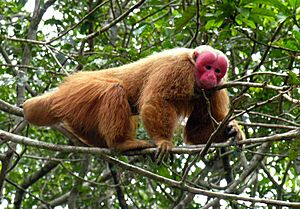Bald uakari facts for kids
Quick facts for kids Bald uakari |
|
|---|---|
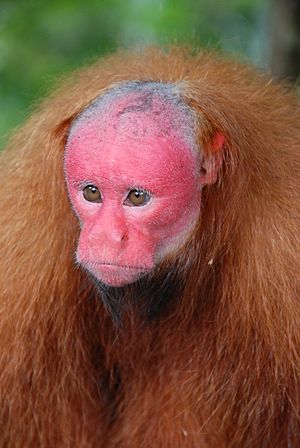 |
|
| Red uakari (Cacajao calvus ucayalii) in Iquitos, Peru. | |
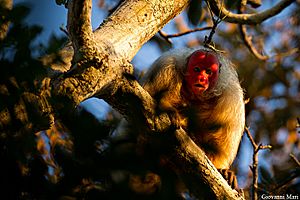 |
|
| White uakari (C. c. calvus) at the Solimões River, Brazil. | |
| Conservation status | |
| Scientific classification | |
| Genus: |
Cacajao
|
| Species: |
calvus
|
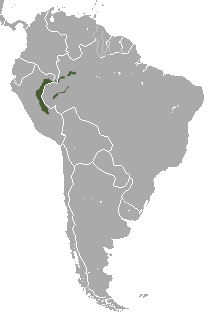 |
|
| species range | |
The bald uakari (Cacajao calvus) is a unique type of New World monkey. It is easy to spot because of its very short tail, bright red face, and bald head. These monkeys also have a long, shaggy coat.
Bald uakaris live only in certain parts of the western Amazon Rainforest. You can find them in Brazil and Peru. They prefer várzea forests and other wooded areas close to water.
Contents
About the Bald Uakari
There are four main types, or subspecies, of the bald uakari. Each of these types is considered vulnerable to extinction. This means their numbers are decreasing and they need protection.
The four subspecies are:
- White bald-headed uakari, Cacajao calvus calvus
- Ucayali bald-headed uakari, Cacajao calvus ucayalii
- Red bald-headed uakari, Cacajao calvus rubicundus
- Novae's bald-headed uakari, Cacajao calvus novaesi
What Does a Bald Uakari Look Like?
Bald uakaris are medium-sized monkeys. They usually weigh between 2.75 and 3.45 kilograms (6.1 and 7.6 pounds). Their head and body together are about 45.6 centimeters (18.0 inches) long for males. Females are slightly smaller, around 44.0 centimeters (17.3 inches).
Their fur can be white or red, and it looks quite shaggy. As their name suggests, their head has no hair. Their tail is very short, only about half the length of their body and head combined. The bright red color of their face comes from many tiny blood vessels close to the skin.
How Bald Uakaris Live
Bald uakaris are arboreal animals. This means they spend most of their lives in the trees. They live in forests that flood during the rainy season in the Amazon River Basin. These forests are found in Peru and Brazil. Living in trees helps them stay safe when the water levels rise high.
During the dry season, they come down to the forest floor. They search for food like seeds and other plant materials. Their diet mainly consists of seeds (67%), fruits (18%), and flowers (6%). They also eat a small amount of animal prey and buds.
What Do Bald Uakaris Eat?
Bald uakaris have a strong lower jaw. This jaw helps them open hard, unripe fruits and nuts. They can eat foods that other monkeys cannot. Sometimes, they also eat insects they find, but insects are not their main food source.
Social Life and Travel
Bald uakaris travel in groups that can have 5 to 30 monkeys. Sometimes, these groups can even be as large as 100 individuals. They can travel up to 4.8 kilometers (3 miles) each day. Females usually stay with the group they were born into, while males often leave.
Each group has a home range of about 500 to 600 hectares (1,200 to 1,500 acres). To protect their area, they use special calls, wag their tails, and make their hair stand up.
Mating and Family Life
The bright red face of a bald uakari is a sign of good health. This helps them find a healthy mate. Their breeding season is from October to May. A female uakari is pregnant for about six months.
Both male and female uakaris have a special gland on their chest. This gland might release a scent that helps them communicate, especially during mating. Females might use a scent to attract males. Bald uakaris can live for about 30 years. Some have lived even longer in zoos.
Protecting the Bald Uakari
The bald uakari is listed as "vulnerable" by the World Conservation Union (IUCN). This means their population has dropped by at least 30% in the last 30 years. The main reasons for this decline are hunting and habitat loss.
Even though their conservation status has improved from "endangered" in the past, their numbers are still going down. Since they live only in specific flooded forests, they are very sensitive to human activities. This includes land being cleared for farms or pastures.
Threats to Their Home
The biggest threats to bald uakaris are losing their forest homes and hunting. Between 1980 and 1990, about 15.4 million hectares (38 million acres) of tropical forests were destroyed each year. The Amazon Basin, where uakaris live, has seen a lot of forest destruction.
Logging, which is cutting down trees for wood, causes a lot of damage. When large trees are cut, it breaks up the forest canopy. This directly affects uakaris because they live in the trees and rely on them for food. Also, since uakari populations are close to the Amazon River, they are at higher risk of being hunted from canoes. People might hunt them for food or for bait.
Who is Helping?
Many groups are working to protect the Amazon rainforest and its animals. In 1999, the Pilot Program to Conserve the Brazilian Rainforest started. This program received money from countries like Germany and Britain to fund conservation efforts.
The Wildlife Conservation Society also has programs in South America. The Amazon-Andes Conservation Program (AACP) began in 2003. It aims to protect several large areas in the Amazon. These protected areas cover about three percent of the Amazon Basin. The Wildlife Conservation Society plans to expand these efforts.
Brazil's national environment agency, IBAMA, is also getting help from the army. They patrol the Amazon to stop illegal logging, mining, and deforestation. These efforts are crucial to help the bald uakari survive.
See also
 In Spanish: Uacarí calvo para niños
In Spanish: Uacarí calvo para niños



